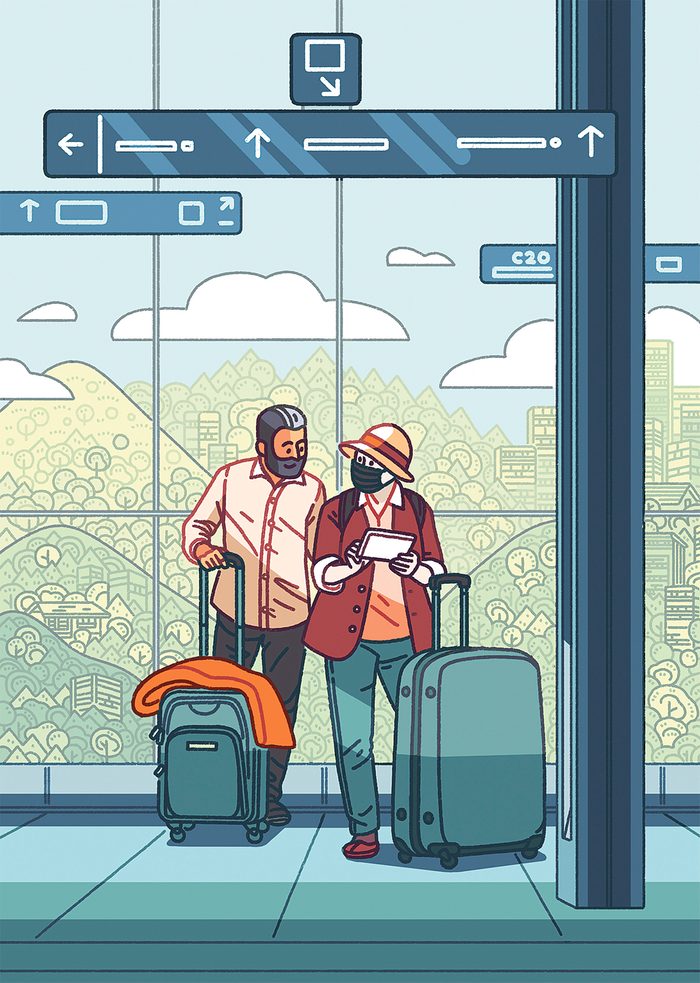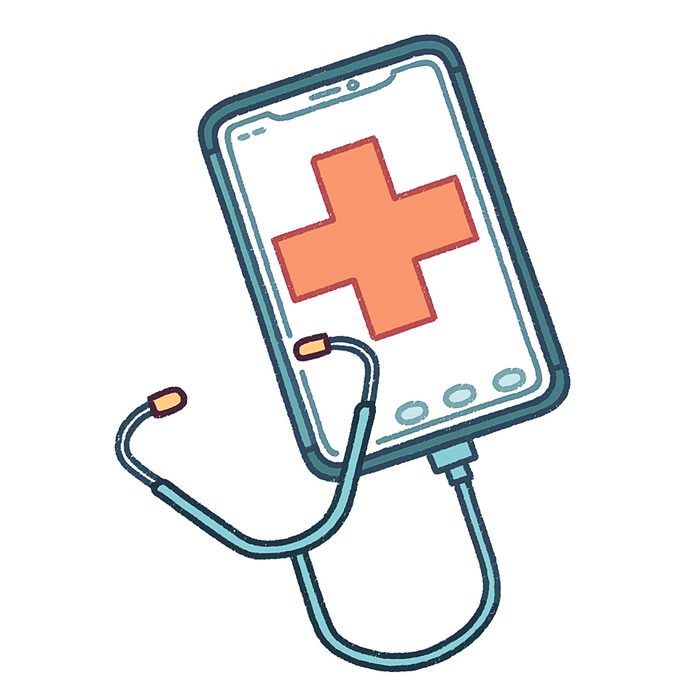
“Is there a doctor aboard?”
No physician wants to hear these words while flying, but this time I was already primed by the frantic sounds of a female passenger in distress. We were over the North Atlantic, and my husband and I were on our way home from a European holiday. The cabin was darkened for the inflight movies when pleas of “Wake up! Oh, help!” rang out.
I was out of my seat, fast. The flight attendant and I arrived together to see a frightened elderly woman clutching the hand of her husband, who wasn’t responding to her pleas. His head was back, his mouth open. He could have been asleep, except that he couldn’t be roused.
I did a quick examination: irregular but steady pulse, colour good, no evident pain, breathing regularly without effort. I sat on the arm of the seat across the aisle, still monitoring his pulse, and asked the woman about her husband. At 80 years old, he had a clean medical history and took no medications. The couple had travelled to Scotland to celebrate their 60th wedding anniversary, and they were on their way home. It had been a good holiday, she said, but tiring.
Suddenly her husband opened his eyes, looked at me, smiled and said, “Hello. What’s happened?”
“Well, you lost consciousness for a few minutes,” I said. “Your heartbeat isn’t quite right, and that may have caused this.”
Soon after, looking down on the expanse of snow over Greenland from the cockpit, I reported to the pilot that there was no other plausible explanation for the man’s episode.
“We can put the plane down in 20 minutes in Gander,” he told me, “or carry on for two hours and land in Toronto. What do you want me to do, doc?”
“Put it down,” I said. It wasn’t worth taking any chances, and the safest thing was to get him hospital care quickly.
Three weeks later, I received a lovely thank you note from this kind gentleman, who will hopefully remain in good health for years to come.
I don’t know for certain what caused the man’s troubles that day on the plane. Maybe he overexerted himself in Scotland; maybe he didn’t rest enough; maybe he was dehydrated. The truth is, travel for seniors can be daunting and stressful, and there’s enormous potential for medical complications, especially for people with pre-existing health issues. But it can also be very exciting and fulfilling.
At 80 years old myself, I love to travel and want to continue for as long as I can. My husband and I recently took walking trips in the Shetland and Orkney islands in northern Scotland and finished in the wind-blown Faroes, east of Iceland. We loved the ancient history and the warm and lively local hosts. Spending time in other parts of the world with people from other cultures adds interest and value to my life.
Though Covid-19 is likely to be part of our lives for the foreseeable future, people are travelling again, and the key to things going smoothly—beyond getting travel insurance—is preparation. Here are steps you can take to enjoy your vacation with minimal stress.

Create a portable medical history
Thanks to mobile phones and tablets, it’s easy to bring your medical history—consultations, test results, imaging reports—with you on your travels. You can take advantage of the available phone apps and digital tools, which vary according to your jurisdiction, that allow you to access your health records. That means you will have this vital information with you no matter where you are.
Even with these details on your mobile device, you should still create a written record of your medical history. Include any surgeries you’ve had and the medications you take (by name, dosage and the time of day you take them).
Put it in your wallet along with your boarding pass, vaccination record and credit cards. Knowing it’s all there is very reassuring. Why? Phones can fail or run out of power. If something goes wrong during your travels and you can’t speak for yourself, your medical summary will provide caregivers with the information they need.
And if you end up receiving medical care while travelling, make sure you get printouts of all the tests you were given so you can show them to your doctors back home. They will be a key component of your follow-up care and will help you avoid retaking tests.
These travel hacks could save your next vacation.

Share your travel itinerary
Send your itinerary to close family or friends, and be sure to include addresses and phone numbers for each destination. This allows your loved ones to keep in touch if you do experience medical problems while you’re away.
And if you, the traveller, are leaving elderly parents at home, make sure whoever is caring for them can reach you if there is a health crisis. Many of my patients in their 60s are raring to go on a trip but worry about leaving a parent for whom they are a caregiver. I never discourage someone from travelling unless the elderly parent has a sudden critical illness.
What if a loved one passes away at home while you’re travelling? Frankly, unless you belong to a religion that requires a quick burial, I believe there is no need for you to race home. This advice assumes that funeral arrangements have already been made for your loved ones, which is simply smart planning. The pandemic has taught us that in the absence of a bedside vigil, it’s the celebration of life that matters.
Stay comfortable on the flight
Flights are physically demanding. The combination of being sedentary and enduring high cabin pressure at altitude can take a toll on our bodies.
So, in addition to donning masks as a precaution against airborne illnesses like Covid-19, my husband and I wear knee-high compression socks on lengthy flights. They reduce or even prevent uncomfortable foot swelling caused by sitting for hours crammed into a small seat. As well, we never take off our footwear while flying. We know that if we do, we’ll be struggling to stuff our swollen feet back into our shoes or boots at the end of the flight.
Compression socks support your legs’ veins and allow better blood flow. This helps prevent swelling and the pooling of blood in the veins, reducing your risk of deep-vein thrombosis, when clots form that can cause a pulmonary embolism.
It’s also very important to get up and walk the aisle during the flight. I recommend taking a stroll every two to three hours. Even if you have to crawl over fellow passengers and risk blocking the food cart in the aisle, it’s worth it for your health’s sake.
Find out how to beat jet lag.

Bring along the basics
Pack a reusable water bottle. Parents today send their kids off to school with water bottles, but rarely do we see elders carrying them—and they should.
If you’re part of a tour group, some excursions at your destination may offer fixed lunch times and rest periods, but many travellers find themselves out all day, often inadequately fuelled and watered.
Be sure to drink regularly throughout the day—staying hydrated can reduce headaches and body aches, which helps you stay focused and, crucially, reduces your chances of falling. I like collapsible lightweight bottles because they’re easy to tuck into small bags; one that holds 750 millilitres of water is enough for a day’s outing but won’t make you desperate for the toilet. Aim to drink around two litres per day in total.
When you do head out for the day, don’t carry too much. It’s well known that the “asymmetrical loading” of shoulder bags stresses the neck and upper body. A small backpack, squarely set on both shoulders, will make all your outings more comfortable.
Put only the necessities into your daypack: water, medications, your medical-history document, sunscreen, hat, credit card and cash. Depending on the weather, you may want to add a sweater, raincoat or compact umbrella. And wearing a mask, especially in crowded places, just makes sense.
Check out the worst mistakes you can make when booking a vacation online.

Don’t be shy about bringing a cane or walker
My patients who travel tell me that they struggle navigating the cobblestone paths, steep roads and narrow stairs they encounter at some destinations. Overseas vacations often include visits to museums, gardens and ancient sites, and that can add up to a lot of walking—often more than 10 kilometres, or about 12,000 steps, a day. It can take a toll on tricky knees, stiff hips or a cranky back.
Many tourist attractions that cater to older travellers offer canes for walking tours and poles for hikes. Some may even provide straps for your ankles and braces for your knees, but it’s better to have your own equipment that you’ve already tried. Consider packing a knee guard (a neoprene sleeve with the kneecap area exposed) or a soft ankle brace. Either could be invaluable, as mild pressure on a tender joint can reduce swelling.
Recently, some friends of mine took their 90-year-old parents on a trip to France. They had to bring along two walkers and a folding wheelchair, all packed in the airplane’s cabin, along with other passengers’ baby strollers. These items allow trips with elderly travellers to be enjoyed, or even to happen in the first place.
Consider borrowing a wheelchair from the airline for use when in transit. They’re not only for the oldest, frailest people—anyone who might have difficulty carrying bags through the airport and standing in lengthy customs and immigration lines will appreciate them.
To avoid over-exerting your body before you even reach your destination, it’s perfectly okay to ask your doctor for a letter requesting the use of a wheelchair for transiting through airports (though airlines wouldn’t typically require a doctor’s note). Some airports even provide large golf carts in lieu of wheelchairs. Ask your airline in advance about the options for your journey.
Discover the world’s greatest museums.
Don’t forget other essentials
You’ve got your passport, reading glasses, sunglasses, money, contact details, medical information, itinerary, phone, power adapters and small bottles of your preferred toiletries. Other all-important basics are sunscreen with an SPF of 50 or higher and a hat to protect your scalp, ears and the back of your neck (areas that never seem to get enough sunscreen).
Don’t forget antibacterial wipes; we’re all now accustomed to hand sanitizer, and the wipes are handy for cleaning surfaces around you, in planes and on buses, for example. And if you want to be super prepared, add an antihistamine to your luggage.
Always pack prescription meds in your carry-on bag, not your checked luggage; replacing them could be difficult if your bags are lost or delayed. And if you are travelling with prescription opiates for chronic pain, bring a letter from your doctor that declares exactly what you’re carrying.
Likewise, if you have diabetes, put your glucometer (to measure your blood sugar) in your carry-on bag. If you are on blood thinners, don’t forget to bring your INR testing kit (which monitors the risk of blood clotting).
Anyone planning to hike in North America or Europe should pack tweezers for removing ticks; you don’t want to get Lyme disease. It’s a serious illness that can dramatically affect the quality of your life. If you’re going to be in the woods or in tall grass, wear a long-sleeved shirt and trousers tucked into your socks. Later, as you get ready for bed, check your entire body for ticks.
The world is waiting
Don’t forget that no matter where you go, you can often rely on the kindness of strangers. I am forever impressed at the trips my elderly patients undertake, and they tell me that part of their confidence comes from knowing that if they need help they can ask for it from the people who live there. People are generally good.
I’ve just returned from an extended stay in Yellowknife, in Canada’s north. When it started snowing heavily, I reached out to locals for advice on how to navigate the sidewalks and roads in the darkness. I was rewarded with assistance, stories and the kind of essential homegrown savvy you would never find in guidebooks.
I find that travel is good medicine for my soul, and it may be good for yours, too. With the world opening up again, don’t shy away from seeing the world. Embrace it.
© 2022, Dr. Jean Marmoreo. From “Travel With Dr. Jean: Preparing For Takeoff,” Canadian Geographic (August 16, 2022), with additions from the author.
Setting sail on your next vacation? Don’t miss these essential cruise tips from a cruise ship insider.